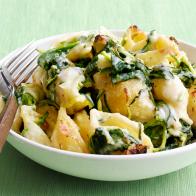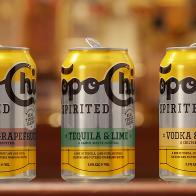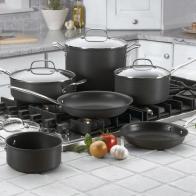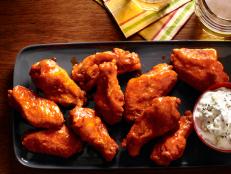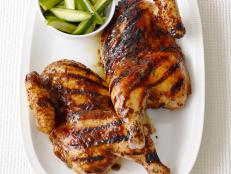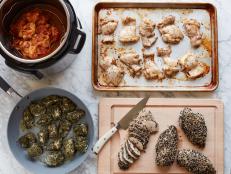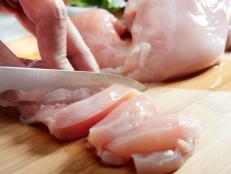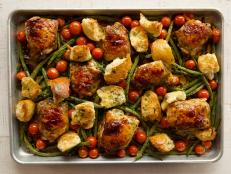How to Minimize Cross-Contamination If You Rinse Raw Chicken
While the official stance of food safety experts is, well, to never do it, there are practical, culinary reasons for doing it anyway.

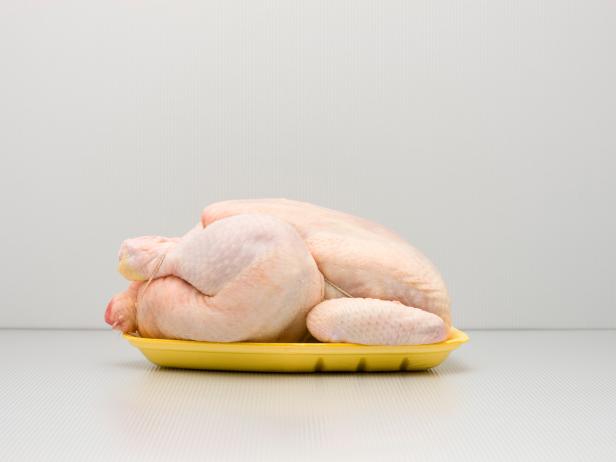
PhotoAlto/Milena Boniek/Getty Images
Every few months, there’ll be a cooking TikTok video that goes viral for exactly the same reason. They start, as most cooking videos do, with an introduction of what’s going to be prepared. The person shows off the ingredients needed to make the recipe and jumps into the instructions. But then they get to the one piece of prep that gives viewers a record-scratch moment: They wash their raw meat.
Chicken is usually the culprit, though ground beef has also received the rinsing treatment. Even the famous are not immune to the debate that ensues over the culinary practice. Last spring, actress Paula Patton sparked outrage when she washed poultry before frying it (and then proceeded to season the oil, rather than the bird, but that’s a controversy for another day). The culinary queen herself, Julia Child, has said that she washes her chicken before cooking, a tip that Jacques Pepin openly challenged in an episode of their show Julia & Jacques Cooking at Home.
The official stance from the Centers for Disease Control and Prevention (CDC) is simple and straightforward: Please do not wash your chicken. It’s something that the organization reminds home cooks of quite frequently, likely because the practice is still fairly common — a 2019 study by the United States Department of Agriculture (USDA) found that 39 percent of participants had chicken washing as part of their cooking process.
The Problem with Washing Chicken
When it comes to preparing chicken — and meat in general — food safety experts agree that washing isn’t necessary and can actually cause more harm than good.
“Rinsing raw poultry will not do anything to help reduce the risks of salmonella or campylobacter or any kind of harmful bacteria that may live on raw chicken,” says Darin Detwiler, author of Food Safety: Past, Present, and Predictions and food policy professor at Northeastern University. “Only proper cooking to the proper temperature can serve as a kill step for harmful bacteria.”
What’s more likely to happen is contamination, which is typically Detweiler’s top concern. “The number one problem is that you’re going to spread pathogens all over your kitchen. It’s going to be on the sink. It’s going to be on the handle of the faucet. It’s going to be on the sponge. It’s going to be on your hands.”
And once the bacteria makes its way to those surfaces, the likelihood that it’ll get on other foods increases. His worry is not so much for the chicken, which will eventually get cooked (hopefully to the CDC-recommend temperature of 165 degrees F), but for the ingredients that won’t be, like the vegetables that are going into a salad or fruit that’s being cut up as an afterschool snack.
Kristen E. Gibson, director of the Center for Food Safety at University of Arkansas, echoes that concern. “The sink and surfaces can be cleaned and sanitized afterwards. However, nearby food cannot be.”
It’s Not Just Cultural — When Washing Your Meat Makes a Difference
Despite the risks of cross-contamination, washing meat is routine for many home cooks. Whenever a chicken washing video does go viral, there’ll be commenters who note that that the practice is more than just a habit. In many households and cultures, washing meat is a step that’s been taught and passed down by generations prior. It’s as integral to the recipe as the ingredients or cooking techniques.
“Part of it is cultural. I’ve heard before that it’s a relic of an agrarian society, when people raised and processed their own livestock. They’re used to rinsing their meat. You watch your grandma do it and you watch your parents do it, so you do it,” says Sarah Leung, who founded the Chinese American cooking blog The Woks of Life with her family. “But I do think that there is a practical reason in a lot of cases.”
Rinsing meat is a step that the Leungs call for in certain recipes when the technique affects the final product. An example she gives from Chinese cooking is bone broth. “With meat that either has bones in it or with bony cuts, I was always taught to rinse or soak before using them because of little bits of bone that might be still there from the butcher cutting through them,” Leung explains. “It also gets rid of impurities, the excess blood or whatever else that might cloud your stock. Some recipes, including ours, involve parboiling the meat first to get rid of that stuff and give your stock or soup a clearer appearance and a cleaner flavor.”
Cleaning raw meat is another critical step in velveting, a Chinese technique that yields the wonderfully tender meat found in stir fries. Leung has tested the process with both rinsed and unrinsed meat and noticed a tangible difference in the texture.
“You’ll see in a lot of Chinese recipes that you’re either rinsing the meat or you’re massaging water into the meat before you stir fry it. That little bit of water really improves the texture. When it hits the hot wok, it gives the meat a juiciness and a slippery texture that doesn’t feel so dry. Because the heat of the wok is so high, if you don't prepare the meat in this way, sometimes it can dry out very quickly.”
Alica Ramkirpal-Senhouse, the Guyanese American recipe developer and writer behind Alica’s Pepperpot, has similar reasons for cleaning meat before cooking. She’s found that washing meat “the Caribbean way” — with water and citrus juice or vinegar — also improves the flavor.
“The main reason that we do it is to tenderize it, to get rid of the sliminess, and also to loosen up any strangling pieces of fat,” she says. This is especially important for recipes that call for whole chickens, like Guyanese curry. “We cook the entire chicken. Because there’s all these different parts, you want to wash it properly. I guarantee you’ll notice a difference because the acid just tenderizes the meat and it shrinks it a little bit, too.”
Because rinsing meat is something Ramkirpal-Senhouse does frequently, she has developed a process in efforts to limit cross-contamination. She starts with an empty sink, places the meat in a stainless-steel bowl, soaks it in water and lime juice, then rinses it off and moves the bowl to the stovetop until she’s ready to cook. Next, she’ll disinfect the sink with a cleaning agent that has bleach in it and wipe down the surrounding area as well, all with disposable paper towels and not a kitchen towel.
“Part of the process is making sure there’s nothing in your way. There’s nothing in the sink. There are no dishes nearby,” says Ramkirpal-Senhouse.
How to Safely Handle Raw Meat
So how does a food safety expert handle their raw chicken? They certainly don’t wash it and, whenever possible, they limit the meat’s contact with other kitchen surfaces by using cutting boards designated for raw meat.
“Typically, I handle raw chicken and meat with a utensil, like tongs, as opposed to with my bare hands. I often will remove the raw product from the package and place it on a plastic cutting board that’s lined with paper towels,” explains Gibson. If needed, she pats the meat dry with paper towels and once she starts cooking, she’ll place anything that’s touched the meat in the sink for cleaning. “Most importantly, I wash my hands any time after I have touched the raw meat product.”
Detwiler also emphasizes the importance of proper handwashing and generally avoids touching anything else in the kitchen if he’s preparing raw meat.
“People will take a raw chicken out of a bag, put it onto a tray, and then immediately go and grab the salt and pepper shaker. Now that salt and pepper shaker is contaminated because you didn’t wash your hands in between. Those pathogens, they can sit there.”
Raw Chicken: To Wash or Not to Wash?
For food safety experts, the answer is an unequivocal no, especially since meat purchased from grocery stores is already washed.
“If you want to wipe off the chicken with a clean paper towel and definitely still wash your hands, that’s one thing,” says Detwiler. “But if you’re wiping it off because it smells funny or it seems soapy, well, that’s an indication of there being a problem already.”
But the issue is less cut and dry from the culinary side, especially when it comes to specific dishes or techniques.
“I understand the recommendation not to do it and the risks of cross-contamination,” says Leung. “But from the perspective of the cuisine that my family cooks, there’s a practical purpose.”
Ramkirpal-Senhouse agrees: “When they say it’s already washed, they just mean they’ve hosed it down with water. It’s not the same as soaking the meat with some lime juice or fresh lemon juice.”
Just make sure you’re doing your due diligence to minimize cross-contamination. “One time, I did see a blogger chopping chicken and she had a pineapple near the sink, a whole pineapple that she was waiting to get ripe,” recalls Ramkirpal-Senhouse. “I had to swipe away.”
Related Content:




